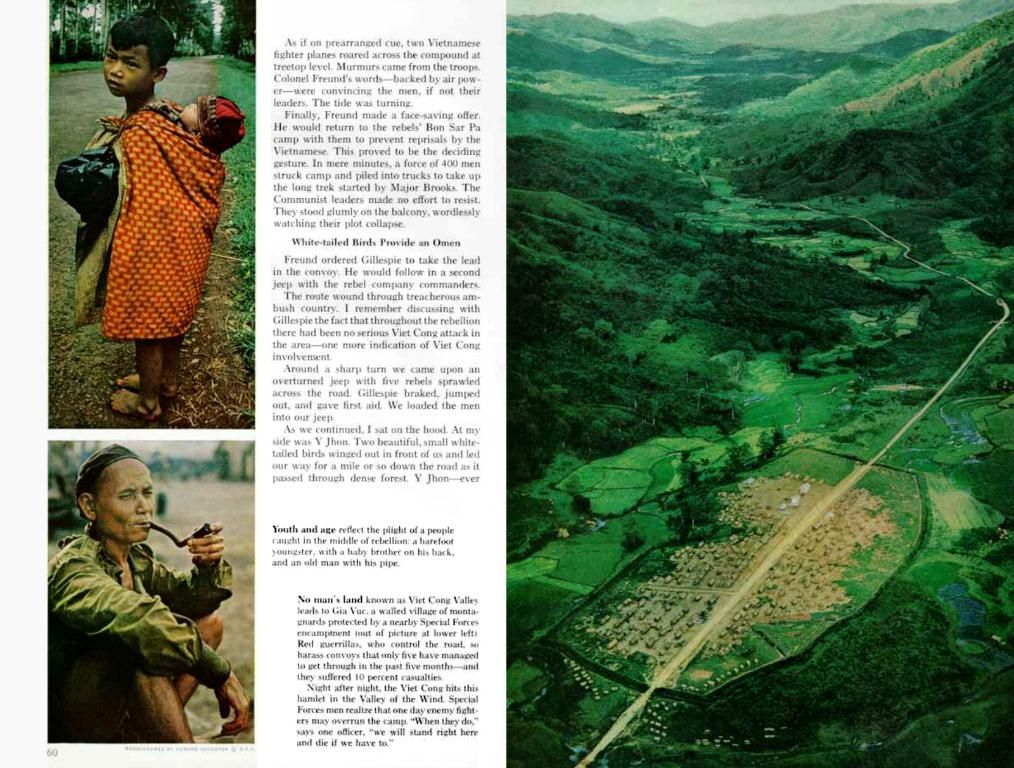Global Nature Restoration Initiatives: Reintroducing Life to Our Planet's Wild Spaces
Living in a world that's increasingly concretized and manipulated, the call for rewilding is resonating louder than ever. This movement aims to breathe life back into our planet and restore once-wild ecosystems to their original, untamed glory. From revitalizing landscapes to encouraging biodiversity, we're unpacking the intriguing world of rewilding.
What's the Deal with Rewilding?
Rewilding involves nurturing nature by stepping back and letting natural processes take the lead. By reintroducing native species, minimizing human interference, and reconnecting fragmented landscapes, we allow ecosystems to regulate themselves. The ultimate goal? To create vibrant environments bursting with biodiversity, all while letting Mother Nature do her thing.
The Birth of Rewilding
Rooted in North America in the ’90s, rewilding was born from a realization of the drastic decline in biodiversity and an appreciation for conservation biology. What initially started as an approach focused on large-scale wilderness areas and keystone species has since evolved into a global movement, tailored to local needs and contexts.
Keystone Species: The Power Players
Keystone species hold the power to drastically impact their ecosystems. By reintroducing key animals like wolves, beavers, or elephants, we can set off a chain reaction, increasing biodiversity and strengthening overall ecosystem health. Take Yellowstone National Park and the comeback of wolves. An overabundance of elk was killing vegetation, but the reintroduction of wolves helped control the population and restore the land.
European Bison: A Roaring Comeback
The comeback of the European bison is a shining example of rewilding success. Once on the brink of extinction, these magnificent creatures can now be found roaming protected areas across Poland, Romania, and the Netherlands. As ecosystem engineers, they help maintain open landscapes, encouraging plant diversity and creating habitats for various species.
Rewilding the Oceans: A Deep Dive
Rewilding doesn't stop at land. Oyster reefs, seagrass beds, and coral reefs are all part of the plan to restore marine biodiversity. These habitats shelter a diverse array of marine life and contribute to healthier oceans. In fact, oyster reefs not only provide shelter but also clean the water by filtering out particulates.
Overcoming Challenges
While rewilding presents numerous benefits, it also faces challenges. Both social, political, and financial barriers often crop up, along with concerns from local communities and stakeholders. Successful rewilding projects require collaboration among governments, conservationists, and local populations to address fears, manage expectations, and ensure sustainability.
City Slickers Enter the Rewilding Game
Urban areas are hopping on the rewilding bandwagon. Cities like London and New York are revitalizing green spaces, rooftops, and abandoned lots, creating bustling ecosystems. Urban rewilding not only boosts biodiversity but also offers recreational opportunities and improves the mental health of city dwellers.
The Wisdom of Indigenous Knowledge
Indigenous communities play a vital role in rewilding efforts. With deep-rooted knowledge of local ecosystems, indigenous communities share valuable insights, ensuring rewilding practices respect cultural heritage and are tailored to specific ecological conditions.
Technology to the Rescue
Advancements in technology are playing a crucial part in rewilding projects around the world. Drones, satellite imagery, and GIS mapping help monitor ecosystems, track animal movements, and gauge the health of rewilded areas. These tools allow for better management, making rewilding initiatives more efficient and effective.
Rewilding's Economic Advantages
Beyond ecological gains, rewilding offers significant economic benefits. Ecotourism, carbon sequestration, and improved ecosystem services like water purification and pollination drive local economies. Many rewilding initiatives create jobs in conservation and tourism, fostering long-term advantages for communities.
A Look at Scotland: A Rewilding Success Story
The Scottish Highlands exemplify the triumph of rewilding efforts. Projects are aimed at restoring native woodlands, peatlands, and even reintroducing animals like the Eurasian lynx. These initiatives have revitalized Scotland's natural heritage, provided habitats for wildlife, and attracted tourists eager to witness the transformation firsthand.
Rewilding's Impact on Mental Health
Rewilding isn't just good for the planet; it's also beneficial for human well-being. Studies have shown that exposure to wild, natural environments reduces stress, improves mood, and enhances mental clarity. By forging a connection with nature, rewilding projects contribute positively to human health and happiness.
International Collaboration: A Global Effort
Rewilding has garnered international attention and support. Organizations like the European Rewilding Network facilitate collaboration, sharing best practices and resources among projects worldwide.
A Bright Future for Rewilding
As rewilding gains momentum, future initiatives look promising. Innovations in wildlife corridors, habitat restoration, and community engagement continue to evolve. With a commitment to rewilding, we're stepping towards a future where the wild isn't just a memory but a thriving, vibrant reality.
Wrapping Up
Rewilding signifies a significant shift in the way we engage with the natural world. By healing landscapes, restoring biodiversity, and fostering sustainable coexistence, we're paving the way for a better, greener planet. While challenges remain, success stories demonstrate the power of letting nature take the wheel. As rewilding efforts grow, they inspire hope for a future where the wild isn't lost but flourishing for generations to come.
Annette Uy
Additional Insights:
- Rewilding projects around the world are gaining momentum as a vital strategy for restoring ecosystems, promoting biodiversity, and mitigating climate change.
- The EU's commitment to restore 20% of its land and sea by the end of the 2020s underscores the global recognition of rewilding as a crucial conservation strategy.
- Rewilding projects often provide economic and social benefits to local communities, enhancing their livelihoods and cultural preservation.
- Rewilding is a movement centred around nurturing nature by stepping back and letting natural processes govern, aiming to create vibrant environments teeming with biodiversity.
- Initiated in North America in the 90s, rewilding grew from a realization of the decline in biodiversity and an appreciation for conservation biology, and has since evolved into a global effort.
- Keystone species, such as wolves, beavers, or elephants, can have a significant impact on their ecosystems, increasing biodiversity and improving overall ecosystem health.
- European bison, once on the brink of extinction, have made a comeback and can now be found in protected areas across Poland, Romania, and the Netherlands, serving as ecosystem engineers that help maintain open landscapes and encourage plant diversity.
- Rewilding efforts extend to the oceans, focusing on restoring biodiversity in environments like coral reefs, oyster reefs, and seagrass beds, which sustains various marine life and contributes to healthier oceans.
- While rewilding offers numerous benefits, challenges like social, political, and financial barriers, as well as concerns from local communities and stakeholders, need to be addressed for successful rewilding projects.
- Indigenous communities play a crucial role in rewilding efforts, sharing deep-rooted knowledge of local ecosystems, and ensuring rewilding practices respect cultural heritage and are tailored to specific ecological conditions.







